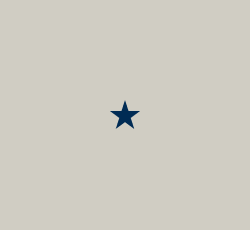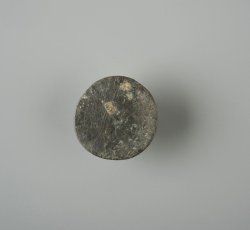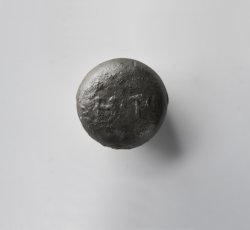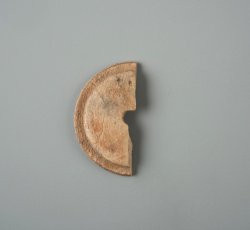House for Families - Page 8 of 18

Colorless glass sleeve button inlay with molded 8-pointed star design
Glass | Object #: 1787157
This is a decorative glass inset which originally was set into the metal backing of a linked, or sleeve, button. Such insets are referred to as “pastes,” and could be colored, cut, or molded, and would have been set into metal backings. This example is a molded, colorless, leaded glass. The dec...
Explore This Item
Colorless glass sleeve button inlay with molded house, 2 trees, fence, and path.
Glass | Object #: 1787164
This is a decorative glass inset which originally was set into the metal backing of a linked, or sleeve, button. Such insets are referred to as “pastes,” and could be colored, cut, or molded, and would have been set into metal backings. This example is a molded, colorless, leaded glass. The dec...
Explore This Item
Faceted colorless glass inset sleeve button.
Copper/Copper Alloy | Object #: 1787193
Catalogued from drawing.
Explore This Item
Bone back to waist coat button with wire eye.
Bone | Object #: 1787213
Bone button molds were disks cut from animal bone, often identifiable by the presence of a single central hole created by a cutting tool during production. The bone disk often served as the back of a two part button. In this button form, the face of the button was commonly comprised of a stampe...
Explore This Item
Bone back to waist coat button with wire eye.
Bone | Object #: 1787433
Bone button molds were disks cut from animal bone, often identifiable by the presence of a single central hole created by a cutting tool during production. The bone disk often served as the back of a two part button. In this button form, the face of the button was commonly comprised of a stampe...
Explore This Item
Bone back to coat button with wire eye.
Bone | Object #: 1787434
Bone button molds were disks cut from animal bone, often identifiable by the presence of a single central hole created by a cutting tool during production. The bone disk often served as the back of a two part button. In this button form, the face of the button was commonly comprised of a stampe...
Explore This Item
Bone button back with carved sunburst design
Bone | Object #: 1787606
Bone button molds were disks cut from animal bone, often identifiable by the presence of a single central hole created by a cutting tool during production. The bone disk often served as the back of a two part button. In this button form, the face of the button was commonly comprised of a stampe...
Explore This Item
Gilt waist coat button with basketweave design and a bone back.
Copper/Copper Alloy | Object #: 1787872
This a two piece button with gilt and basketweave decoration. In this style of button, a disk of lathed bone with a beveled edge often served as a button back. In the earliest examples of this style from the mid-eighteenth century such as this example, four eye holes were drilled into the bone ...
Explore This Item
Flat disc tombac waist coat button with iron shank.
Tombac | Object #: 1787900
This is a one piece metal button, which archaeologists often refer to as “flat disc” buttons. One piece buttons were often made of copper alloys. This particular example is cast tombac as denoted by the “grey” coloration seen below the corrosion on the button face. Tombac is an alloy of copper ...
Explore This Item
Flat disc waist coat button with iron shank.
Tombac | Object #: 1788229
This is a one piece metal button, which archaeologists often refer to as “flat disc” buttons. One piece buttons were often made of copper alloys. The shank of this button was a length of iron wire which was inserted into the mold as the button was cast. Once solidified, the casting lines and ex...
Explore This Item
Unidentifiable copper alloy button
Copper/Copper Alloy | Object #: 1788231
This is the metal back of a two piece button. In this style of button, the face, or cover, of the button was commonly fashioned from a sheet of thin metal, usually a variety of copper alloy. Backings for these buttons provided both strength and a method of attaching the button to clothing, eith...
Explore This Item
Copper alloy 2-piece button back.
Copper/Copper Alloy | Object #: 1788235
This is the metal back of a two piece button. In this style of button, the face, or cover, of the button was commonly fashioned from a sheet of thin metal, usually a variety of copper alloy. Backings for these buttons provided both strength and a method of attaching the button to clothing, eith...
Explore This Item
2-piece button with wooden back
Wood | Object #: 1788309
This is the hardwood back of a two piece button. In this style of button, the face, or cover, of the button was commonly fashioned from a sheet of thin metal, usually a variety of copper alloy. Backings for these buttons provided both strength and a method of attaching the button to clothing, e...
Explore This Item
Coat button with Sheffield plate silver face.
Copper/Copper Alloy | Object #: 1788365
This is the metal face, or front portion, of a two piece button. In this style of button, a disk of lathed bone with a beveled edge often served as a button back. The face of the button was commonly fashioned from a sheet of thin metal, usually a variety of copper alloy, cut into the approximat...
Explore This Item
2-piece "Death Head" button face with silver/tin plating.
Copper/Copper Alloy | Object #: 1788584
This is the metal face, or front portion, of a two piece button. In this style of button, a disk of lathed bone with a beveled edge often served as a button back. The face of the button was commonly fashioned from a sheet of thin metal, usually a variety of copper alloy, which would be crimped ...
Explore This Item
Cast domed pewter waist coat button with "H" and "P" touch mark
Pewter | Object #: 1789039
This is a one piece cast pewter button with a domed face. Pewter was an alloy used throughout the eighteenth century, and was comprised of tin and either copper, antimony, or lead. The low melting point of pewter meant that it was easy to cast in molds. Evidence of the casting process can be se...
Explore This Item
Carved bone coat button back with beveled edge and one eye.
Bone | Object #: 1789040
Bone button molds were disks cut from animal bone, often identifiable by the presence of a single central hole created by a cutting tool during production. The bone disk often served as core to either a cloth covered or a two part metal button. In cloth covered buttons, the bone mold served as ...
Explore This Item
Carved bone coat button back with beveled edge and one eye.
Bone | Object #: 1789047
Bone button molds were disks cut from animal bone, often identifiable by the presence of a single central hole created by a cutting tool during production. The bone disk often served as core to either a cloth covered or a two part metal button. In cloth covered buttons, the bone mold served as ...
Explore This Item
Carved bone coat button back with beveled edge and one eye.
Bone | Object #: 1789049
Bone button molds were disks cut from animal bone, often identifiable by the presence of a single central hole created by a cutting tool during production. The bone disk often served as core to either a cloth covered or a two part metal button. In cloth covered buttons, the bone mold served as ...
Explore This Item
Carved bone button back with beveled edge and one eye.
Bone | Object #: 1789052
Bone button molds were disks cut from animal bone, often identifiable by the presence of a single central hole created by a cutting tool during production. The bone disk often served as core to either a cloth covered or a two part metal button. In cloth covered buttons, the bone mold served as ...
Explore This Item